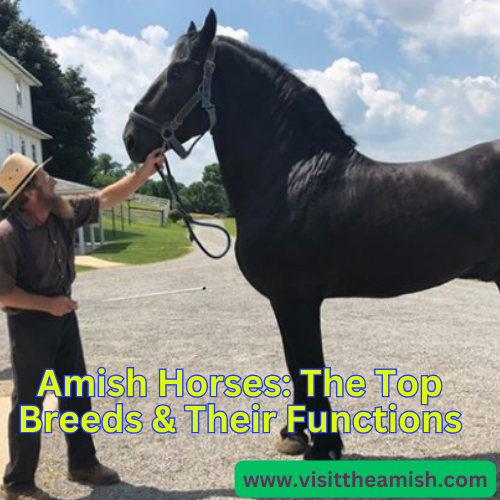Riding Through Time: The Majestic Amish Horses and Their Enduring Bond
Nestled in the heart of rural America, the Amish community has maintained a unique way of life that honors tradition, simplicity, and a deep connection with nature. At the center of this lifestyle, the Ample Horses play a vital role, serving as trusted companions, reliable workhorses, and symbols of the Amish commitment to self-sufficiency. In this article, we’ll explore the fascinating world of Amish horses, their history, and the unbreakable bond they share with their human counterparts.
A Brief History of Amish Horses

The Amish, a conservative Christian sect, migrated to the United States in the 18th century, bringing with them their customs, beliefs, and a reliance on horses for transportation, farming, and other daily tasks. Over the centuries, the Amish have developed a unique relationship with their horses, one that is steeped in tradition and respect.
Amish horses are typically draft breeds, such as Belgians, Percherons, and Clydesdales, known for their strength, endurance, and calm temperament. These horses were originally bred for heavy farm work, but they have become an integral part of Amish culture and identity.
The Role of Horses in Amish Life
Amish horses are not just beasts of burden; they are cherished members of the community. They serve a multitude of purposes, including:
- Transportation: Amish families rely on horse-drawn buggies for everyday travel, from visiting neighbors to attending church services.
- Farming: Horses are essential for plowing fields, pulling wagons, and performing other agricultural tasks.
- Companionship: Amish horses are often treated as pets, and children are taught to care for and respect them from a young age.
- Symbolism: Horses represent the Amish commitment to self-sufficiency and their rejection of modern technology.
The Amish Horse-Drawn Buggy

The Amish buggy is a familiar sight on rural roads, and it serves as a symbol of the Amish way of life. These buggies are typically built by local craftsmen and are designed to be simple, functional, and durable. The buggy’s construction reflects the Amish values of modesty and practicality.
Amish buggies come in various styles, including the open-top “sulky” buggy, the enclosed “standard” buggy, and the larger “family” buggy. Each type serves a specific purpose, from daily transportation to hauling goods or transporting large families.
Training and Care of Amish Horses
Amish horses are trained with patience and kindness, often by the children of the community. Training begins early, with young foals learning to accept a halter and lead rope. As they grow, horses are taught to respond to voice commands and to work alongside their human partners.Amish horses are well cared for, with regular grooming, shoeing, and veterinary check-ups. They are fed a balanced diet of hay, grain, and fresh water, and are given ample time to rest and graze. The Amish believe that treating their horses well is not only a moral obligation but also a practical necessity, as healthy, happy horses are more productive and reliable.
The Amish Horse Auction
One of the most fascinating aspects of Amish horse culture is the horse auction. These events, which occur throughout the year, serve as a meeting place for Amish communities and a marketplace for buying and selling horses.
At an Amish horse auction, horses are paraded before potential buyers, who assess their conformation, temperament, and work ethic. Bidding is spirited, and the highest bidder takes home a new horse, often paying in cash. The auction is a social event as well, with friends and neighbors catching up and sharing news.
The Future of Amish Horses

Despite the increasing encroachment of modern technology, the Amish remain committed to their traditional way of life, and horses continue to play a vital role. However, the Amish are not immune to the challenges of the modern world, and some communities have begun to experiment with alternative forms of transportation, such as bicycles and tractors.
Still, the bond between Amish horses and their human partners remains strong, and the future of these majestic animals is likely to be one of continued service and companionship. As long as the Amish continue to value simplicity, self-sufficiency, and tradition, their horses will remain an integral part of their community and culture.
Conclusion
The Amish horses are more than just animals; they are cherished members of the Amish community, serving as trusted companions, reliable workhorses, and symbols of the Amish commitment to tradition and self-sufficiency. From their role in transportation and farming to their importance in social events like the horse auction, these majestic animals have a unique and enduring bond with the Amish people. As we look to the future, it is clear that the Amish horses will continue to play a vital role in the lives of their human partners, riding through time as a testament to the enduring power of tradition and the unbreakable bond between man and beast.

